|
Abhaya (आभा)
Sanskrit. 'Unafraid, fearless'.
A god that is also the patron saint of the Sakya clan, and to whom the
newborn Siddhartha was presented in the temple of the same name
according to ancient tradition.

Abhimanyu (अभिमन्यु)
Sanskrit. 'Excessive anger'. Son of Arjuna and
Subhadra. He was a brilliant warrior who whilst still in his mother's
womb had learned the knowledge of penetrating into the Chakravyuha, a
seven-tier defensive spiral formation, by overhearing Arjuna talking
about it with his mother. However, his mother fell asleep while she was
being explained about it and so he could not learn how to escape from
it, hence he later died in battle trying to break free from the
Chakravyuha. Shortly after his death his wife Uttara had a miscarriage
but the child named Parikshit was brought back to life by Krishna and
eventually succeeded Yudhishthira as king of Hastianpura.


Adi-Buddha
(आदिबुद्ध)
Sanskrit. 'The original Buddha'. The supreme
primordial Buddha in the Vajrayana sect of Mahayana Buddhism, who
created himself from the original void. In true essence this Buddha is
abstract, illusionary and inconceivable. Therefore he cannot be
represented in art, unless in his revealed and more earthly forms such
as Vajradhara and Vajrasattva, as found in Khmer art, and the various
bodhisatvas. Vairochana is considered the Javan Adi-Buddha. Usually
depicted in royal attire or in hermaphrodite union with a consort, a
principle in Vajrayana Buddhism known as yabyum.

Aditi (अदिति)
Sanskrit. 'Unbounded, free'. The Vedic goddess of
space and mother of all creatures and gods. Her first offspring were the
Adityas. One of them, Daksha, is considered both her daughter and
mother. In later mythology she appears as the wife of the seer Kasyapa,
by whom she became the mother of Vishnu in his avatar as Vamana, and of
Indra. Besides this she is the goddess of the sky, consciousness, the
past, the future and fertility.

Aditya (आदित्य)
Sanskrit. 'Sun'. Sons of Aditi. Each of them
represent a certain aspect of natural phenomena. In scriptures they
first appear as just six then later seven, of whom Varuna was the first.
They then became eight in number and eventually twelve, personifying the
sun in the twelve months of the year. They have different names, many
epithets of the sun. They represent aspects of light and are jointly
identified with Aditya, the sun.

Agastya (अगस्त्य)
Sanskrit. An Indian hermit or rishi who it is
believed brought Hinduism to South India. He appears in the Ramayana and
is a scholar in literature and science. In Java he appears as the
Bhattara-Guru and is associated with the worship of Shiva.

Agni (अग्नि)
Sanskrit. 'Fire'. One of three great Vedic gods with Indra and Surya. He
presides over the earth and is known as the god of fire whilst Indra
presides over the air and Surya over the sun and sky. He is the mediator
between man and the gods and thus the originator of sacrificial rites.
He is one of the eight lokapalas protecting the main wind directions,
presiding over the Southeast and is often depicted with a ram.

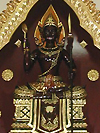
Ai-ma
Lahu. Mother goddess of the earth with the Lahu
people.

Airavata (ऐरावत)
Sanskrit. 'Child of the water'. The multi-headed
white elephant divinity of Hindu-Buddhist religion, in Thailand called
Erawan, and produced during the churning of the Ocean of Milk. He is the
symbol of the clouds and the vahana of the deity Indra, the Vedic god of
the heavens, weather and war as well as one of the elephants that
support the four directions of the world. He generally appears with
three heads though sometimes may have 33 heads, representing the various
heavenly states. One text even mentions Erawan as a 100 headed white
elephant serving as a mount to Narai. The 2nd version of the Ramakien,
written by Rama II, fully describes Erawan when Indrachit, one of the
demon characters disguised as Indra succeeds in fooling the monkey
general Hanuman. Sometimes depicted with Ganesha as its rider.

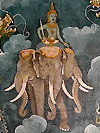
Ajita (अजित)
Sanskrit. Name of one of the eighteen arahats, who
in art is depicted riding or in companion of a deer. According to
legend, Ajita belonged to a high caste brahmin family and was once a
powerful government official, highly trusted by the king. Someday, he
decided to become a Buddhist monk and, not wanting to hear any
entreaties from the king, he left to enter a monastery deep in the
mountains. One day, he appeared in front of the palace, riding a deer.
The palace guards who recognized him quickly reported their findings to
the king, who rushed out to welcome Ajita back, offering him his former
position. However, Ajita turned down the offer and instead convinced the
king to join him to become a monk. The name Ajita means 'invincible' or
'undefeated' and some claim he is the same person as the future Maitreya
Buddha. Besides this, Ajita is often switched with Pindola, an arahat
who is shown with long eyebrows. Therefore, if Pindola is shown on the
deer, then Ajita is depicted with long eyebrows, and vice versa. In
Chinese he is known as the luohan Qi Lu, literally 'To Mount a Deer'. In English he is referred to as the
Deer-Sitting Lohan or the Arhat Riding a Deer, and in Thai he is also
known by the name Asatoh. Sometimes transcribed Achita, Acita,
Asita or Ashita.

_small.jpg)
alvar (ஆழ்வார்கள்)
Tamil. 'Immersed' or 'those immersed in god'.
Vaishnava poet saints from the 6th to 9th century. There are believed to
be ten or twelve and are regarded as incarnations of the attributes of
the god Vishnu. They are worshipped as minor gods.

Amareswara
(अमरेश्वर)
Sanskrit. A title given to both Vishnu, Indra and
Shiva, meaning 'lord of the immortals'.

Amitabha (अमिताभ)
1. Pali-Sanskrit. One of the five transcendental
or dhyani buddhas of Mahayana Buddhism who reigns over western paradise
and is the personification of Eternal Light. It is believed that by
calling on this buddha it is possible to be reborn in paradise and
consequently gain enlightenment and become a buddha in the next life,
thus making him one of the most popular jinas. In China and Japan he
even replaced the Shakyamuni Buddha in importance. In art he is usually
depicted seated in meditation. The male deity Avalokitesvara always
wears a figure of Amithaba in his headdress, of whom he is an emanation.
Also Amida.
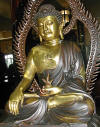
2. Pali-Sanskrit. The historical Buddha.

amrita (अमृता)
Sanskrit. 'Non-death'. The elixir of immortality
produced when the gods and demons churn the Ocean of Milk in the Indian
epic of the Ramayana. The legend also appears in the Hindu epic poem
Mahabharata. Often identified with soma, a nectar of immortality.

Ananda
Cousin of Siddhartha Gautama and chief disciple of
the Buddha. In art often represented as a young monk accompanied by the
elderly Kassapa.

Ananta (अनन्त)
1. Sanskrit. 'Boundless', 'eternal' and
'infinite'. Mythical serpent with one thousand heads on which the god
Vishnu rests during the nights that separate two cosmic time periods.
This theme, known as Anantasayin, is popular in Southeast Asian
architectural decorations. He is king of the serpents and the symbol of
the cosmic waters. When the gods and demons churned the Ocean of Milk to
retrieve the nectar of immortality, they used him as the churning rope.
Also known as Shesha or Sesha, and Vasuki. 2. Sanskrit. 'Boundless',
'eternal' and 'infinite'. An epithet for the Hindu god Vishnu.


Anantasayin
(अनन्तशायिन्)
Sanskrit. 'Vishnu resting'. Epithet used for the
Hindu god Vishnu when reclining on the back of the coiled serpent Ananta
during his cosmic sleep, when he rests during the nights that separate
two cosmic time periods. It is a popular theme in Southeast Asian
architectural decorations.


Angada (अंगद)
Monkey warrior, son of Vali.

Angaja
(อังคชะ)
Sanskrit-Thai. Name of one of the eighteen arahats,
who according to one legend, was a snake-catcher. He is usually depicted
as a jolly, obese figure, carrying a large cotton sack on his back, in
which he would put the snakes after they were caught. He would remove
their venom and then release them into the wild, thus exchanging bad for
good, a kindness that allowed him to attain Enlightenment. He may also
be portrayed holding a fly whisk and an incense bowl. In Chinese he is
known as the luohan Budai, literally 'Cloth Sack' or 'Cloth Bag'.
He is believed to be an incarnation of Maitreya and is in Thai known by
the names Ingada and Ikatoh. In English he may be
referred to as the Calico Bag Lohan or simply the Arhat with a Sack.
Besides this, he is also called Angida and in Thai Angila, Patoh Haw
Siang and nicknamed Phra Thong Phluy,
meaning 'Fat Belly Monk'. He is associated with the Chinese monk Mi Le Fo and Huan Xi Fo.


Angulimala
(अङ्गुलिमाला)
Sanskrit. 'Garland of fingers'. The delinquent son
of a brahmin who entered into the service of an evil master. He was a
bandit who wore a necklace of cut-off fingers but was converted by the
Buddha in Parileyyaka forest, in the eleventh year after the Buddha's
Enlightenment.

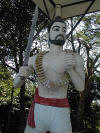
apsaras (अपसरा)
Sanskrit. The female divinities or nymphs and
celestial dancers of the Tavatimsa heaven. They were produced during the
'churning of the Ocean of Milk'. From Sanskrit their name can be
translated as 'emerged from liquid', ap meaning 'liquid' and sara
meaning 'to move or emerge from'. In Hindu mythology they are the
companions of the gandharvas, the male celestial musicians, but in Khmer
mythology they appear solitary, mainly in temple decorations. The are
the attendants of Kama, the god of love and they are able to change
shape at will. They are sometimes employed by the gods to seduce
ascetics, and are the sensual reward for kings and braves who died a
hero's death. In art they are often depicted in murals and lintels,
floating in the air.


Apsonsi
(อัปสรสีห์)
Thai. Creature from Thai mythology with a body
that is half woman and half lion. Also called Apsonsingh, Apsonsingha,
Apsarasingha or Apsarasingh, being the compound of an apsara (apson) and
a singha (singh), that is a female nymph and a lion. The combination of
a male angel and a lion is called Thepnorasi.

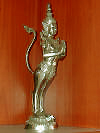
Arada Kalapa
Sanskrit. Brahman master whose principles thought
of the essential non-existence of all things, and to whom Siddhartha was
at first apprenticed after the Great Departure in his search for the
redemption of suffering, caused by the cycle of endless rebirths. In
Pali called Alara Kalama.

arahat
Pali. 'The worthy one', a title given to Buddhist
saints. A term derived from the Sanskrit word arihan, meaning
'foe-slaying'. In Theravada Buddhism, one who has attained the highest
level of spiritual perfection leading to nirvana and is freed from the
cycle endless of rebirths. Some revered Buddhist monks are regarded as
arahats. In the earliest Indian sutras, the Sakyamuni Buddha is said to
have asked four arahats to remain in the world to propagate the dhamma,
one for each of the four directions of the compass, until Maitreya, the
next Buddha, arrived. These four arahats are sometimes said to be Maha
Kasyapa, Kundopadhaniya, Pindola and Rahula, though other sources
mention Panthaka, Nakula, Pindola and Kanakavatsa. The arahats extended
their lives through magical powers and remain accessible to those in
need. Later tradition increased their number from four to sixteen,
referring to the number of saintly ascetics who gathered at the death
and Mahaparinirvana of the Buddha, and then on to eighteen, especially
in Chinese tradition where they probably derived from a Chinese
institution during the reign of T'ai Tsung, who in the year 621 AD
selected eighteen Cabinet Ministers, all officials of high standing,
sound learning and good literary attainments who according to popular
belief became immortals. Others however, believe that they are based on
the fact that it was supposed by some that there were formerly eighteen
gods regarded as protectors of Chinese Buddhist temples, and that the
Eighteen Arahats took their places. The Sixteen Arahats are known as
Pindola Bharadvaja, Kanaka Vatsa, Kanaka Bharadvaja, Subinda, Nakula,
Bhadra, Kalika, Vajraputra, Jivaka, Panthaka, Rahula, Nagasena, Angaja,
Vanavasin, Ajita and Chudapanthaka. Maha Kasyapa and Kundopadhaniya were
eliminated from the first list of four arahats and replaced by fourteen
new ones. Since the Eighteen Arahats have never received authoritative
recognition, the names of the two extra arahats often vary. Sometimes
Maitreya and Maha Kassapa are added to the list of sixteen, in other
places it may be Nandimitra and a second Pindola. In addition, Maha
Kassapa may also be spelled Maha Kasyapa, referring to one of the four
original arahats assigned by the Buddha to remain and guard the dhamma.
Also the identity of Maitreya is something of a problem as originally
the arahats were to remain on guard until Maitreya came. This however
becomes irreconcilable if he is one of them. Besides this, Japanese
tradition also reveres a group of 500 arahats, based either on the 500
disciples that were present when the Buddha expounded the Flower Sutra
on Vultures Peak or on the 500 rich merchants, who became beggars after
meeting and accepting the Buddha's teachings. Also arhat, arhan, arihat
and arahan. In Chinese called luohan and in Japanese rakan, an
abbreviation of the Japanese term arakan, itself a translation of
the Sanskrit word arahan.


Ardhanari
(अर्धनारी)
Sanskrit. Hermaphrodite depiction of the Hindu god
Shiva and his consort Uma or Parvati reflecting a composition of male
and female energy. One side represents the god Shiva with a jata, his
typical plaited hairstyle, the other side represents his consort wearing
a crown. In Vajrayana Buddhism this unity of feminine and masculine
principle is known as yabyum.


arihan (अरिहन्)
Sanskrit. 'Foe-slaying'. A compound in which ari
means 'enemy' or 'foe' and han means 'to kill' or 'to slay'. It is the
name given to Buddhist saints, those who have reached the highest goal
in Theravada Buddhism, as they have slain their greed, anger and
delusions, and destroyed their karmic residue from previous lives. They
are no longer reborn into the world of suffering, no longer trapped in
the cycle of rebirth known as samsara. In Mahayana Buddhism, however,
the arihan ranks below the bodhisattva on the chain of Enlightenment.
See also arahat.

Arishta (อริษฏ)
Thai-Sanskrit. Demon in the appearance of an ox,
sent out by Kansa to kill his nephew Krishna. See also Kuvalayapida.

Arjuna (अर्जुन)
Sanskrit. 'White'. King of the Haihayas of the
Pandava tribe, and the legendary hero of the Indian epic Mahabharata,
the great battle of the Bharatas. Pandu, his natural father, chose Indra
as his divine and spiritual father. Krishna is his charioteer.

Aruna (अरुण)
Sanskrit. 'Reddish brown'. Hindu god of dawn. His
name refers to the colour of the sky during sunrise. He is the
charioteer who drives the sun god Phra Ahtit across the sky and over the
horizon, thus causing dawn.

%20Hindu%20god%20of%20dawn_small.jpg)
Ashwin (अश्विन)
1. Sanskrit. Often plural. 'Horseman/horsemen'.
Name of two Vedic deities, twin sons of the sky or the sun. They are the
personification of early morning light and said to be the children of a
nymph called Ashwini who disguised herself in the form of a mare. Also
transcribed Ashvin. 2. Sanskrit. The twelfth month of the Hindu
calendar.

Ashwini (अश्विनि)
Sanskrit. 'Horse woman'. A nymph who concealed
herself as a mare, mother of the two 'horsemen' brothers, the Ashwin
twin(s).

Asita (असित)
Sanskrit. The hermit living in the mountains not
far from the palace of Suddhodana, and who predicted that if the newborn
Siddharta were to grow up in the palace, he would become a great king
who would submit the whole world, but if he were to deny court life to
live a religious life, he would become a buddha. Some texts mention a
reusi named Kaladevaila.

asura (असुर)
Sanskrit. A demi-god or demon who represents the
forces of darkness and evil, and who is constantly at war with the devas
or gods.

Asurapaksi
(อสูรปักษี)
Thai. A mythical half-animal half-celestial being
from Himaphan Forest with the head of a yak (giant) and the body of a
bird. Similar to the Asurawayupak.

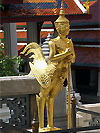
Asurawayupak (อสูรวายุพักทร์)
Thai. Name of a mythical half-animal
half-celestial being from Himaphan Forest with the upper body of an
asura and the lower body of a bird. Similar to the Asurapaksi.

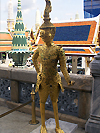
Asurindarahu (อสุรอินดะราหุ)
Name of a giant who wanted an audience with the
Buddha. Proud of his size he didn't want to bow before the much smaller
Buddha. Aware of the thoughts of the giant the Buddha manifested himself
lying down with an enormous body, his feet larger than the body size of
this giant. Totally impressed Asurindarahu learned a lesson, namely that
there might always be more important or larger beings than one expects
and therefore one better not believe rumours without prior
consideration. Giant reclining Buddha images often refer to this
narrative.

Avalaka
Name of an ogre with immense powers who terrorized
an entire city. However, this yaksha converted to Buddhism in the
seventh year after the Buddha's Enlightenment.

Avalokitesvara (अवलोकितेश्वर)
Sanskrit. 'Lord of compassion' or 'the one who
looks down with compassion'. A male deity and popular bodhisatva in
Mahayana Buddhism. He is the personification of compassion. He has
attained enlightenment, but postpones his buddahood in order to help
others to reach that goal. He wears the image of Amitabha in his
headdress and his body is sometimes covered with numerous small images
of the Buddha. This in combination with more arms spread out fan-wise
like a halo around his body, he is known as Radiating Avalokitesvara. He
is sometimes depicted with the skin of an antelope over his left
shoulder or a tiger skin around his waist. He may have up to 22 arms and
11 heads. In Khmer art his attributes are a rosary, book, flask and a
lotus, though he has many forms with different names, and is called
Lokesvara and Padmapani in Southeast Asia. In China he appears in a
feminine form as Kuan Yin, the goddess of mercy, in Japan known as
Kwannon, and in Tibet the Daila Lama is considered an incarnation of
this bodhisatva.

_small.jpg)
avatar (अवतार)
Sanskrit. 'Descendant'. The descent of a Vedic
deity from heaven who incarnates on earth. Usually the term refers to
the god Vishnu who incarnated as the fish Matsya, a tortoise, a boar, a
man-lion or Narasingha, a dwarf or Vamana, Balarama, Ramachandra,
Krishna and the Buddha. His tenth and future avatar is the white horse
Kalkin, due to occur at the end of the present time period called Kali
Yuga. In Thai pronounced avatan and in Pali avatara.

Avatarana (अवतारन)
Sanskrit. 'To descent'. The dwelling place of the
nocturnal malevolent demons known as Rakshasas.
 |